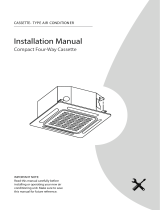
Installation Manual - B-VMH18,24UU-1
2
1. PRECAUTIONS
The safty precautions listed here are divided into two categories.
After completing the installation, make sure that the unit operates
properly during the start-up operation. Please instruct the customer
on how to operate the unit and keep it maintained. Also,
inform customers that they should store this installation manual
along with the owner's manual for future reference.
Be sure only trained and qualified service personnel
install, repair or service the equipment.
Improper installation, repair, and maintenance may result in
electric shocks, short-circuit, leaks, fire or other damage to
the equipment.
CONTENTS
PAGE
PRECAUTIONS.......................................................................................2
INSTALLATION INFORMATION...............................................................3
ATTACHED FITTINGS..............................................................................4
INSPECTING AND HANDLING THE UNIT.................................................5
INDOOR UNIT INSTALLATION.................................................................5
OUTDOOR UNIT INSTALLATION..............................................................7
CONNECT THE DRAIN PIPE...................................................................10
INSTALL THE CONNECTING PIPE.........................................................11
AIR EVACUATION..................................................................................15
WIRING.................................................................................................16
TEST OPERATION..................................................................................17
Install strictly according to this installation instruction.
If installation is defective, it will cause water leakage,
electrical shock and fire.
When installing the unit in a small room, take measures
to keep refrigerant concentration from exceeding
allowable safety limits in the event of refrigerant leakage.
Contact the place of purchase for more information.
Excessive refrigerant in a closed ambient can lead to oxygen
deficiency.
Use the attached accessories parts and specified parts
for installation.
otherwise, it will cause the set to fall, water leakage,
electrical shock and fire.
Install in a strong and firm location which is able to
withstand the set' s weight.
If the strength is not enough or installation is not properly
done, the set will fall and cause injury.
Before obtaining access to terminals, all supply circuits
must be disconnected.
For electrical work, follow the local national wiring
standard, regulation and these installation instructions. An
independent circuit and single outlet must be used.
If electrical circuit capacity is not enough or there is a
defect in electrical work, it will cause electrical shock fire.
Use the specified cable and connect tightly and clamp
the cable so that no external force will be imposed on
the terminal.
If connection is not perfect, it will cause heat-up or fire at the
connection.
Wiring routing must be properly arranged so that control
board cover is fixed properly.
If control board cover is not fixed perfectly, it will cause
heat-up at connection point of terminal, fire or electrical
shock.
If the supply cord is damaged, it must be replaced by the
manufacturer or its service agent or a similarly qualified
person in order to avoid a hazard.
When carrying out piping connections, take care not to let
air substances go into refrigeration circuit.
Otherwise, it will cause lower capacity, abnormal high
pressure in the refrigeration cycle, explosion and injury.
Do not modify the length of the power supply cord or use
an extension cord, and do not share the single circuit with
other electrical appliances.
Otherwise, it will cause fire or electrical shock.
Carry out the specified installation work after taking into
account strong winds, typhoons or earthquakes. Improper
installation work may result in the equipment falling and
causing accidents.
If the refrigerant leaks during installation, ventilate the
area immediately.
Toxic gas may be produced if the refrigerant comes into
contact with fire.
CAUTION
WARNING
WARNING
If you do not follow these instructions exactly, the unit
may cause property damage, personal injury or loss of life.
If you do not follow these instructions exactly, the unit
may cause minor or moderate property damage,
personal injury.
Keep this manual where the operator can easily find it.
Read this manual carefully before starting the unit.
For safety reasons the operator must read the
following cautions carefully.
Installation must be performed in accordance with
the requirement of NEC and CEC by authorized personnel
only.(Applicable to the North American area only)
























